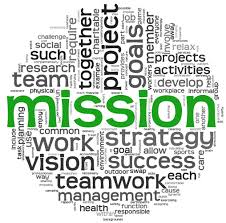You’ve followed the suggestions provided on previous pages about developing a mission statement and are now ready to implement that mission. If you’ve used an inclusive process to develop the statement, your efforts will be rewarded in this implementation phase: you’ve demonstrated an understanding of the importance in the development of acceptance, commitment, and ownership. Now, in implementation, you can benefit from your efforts thus far…
1. Form an ad hoc committee.
Select a working party representative of all groups in the organisation – management and staff. This team, established for the specific purpose of successfully implementing the new mission, will be disbanded after this intention has been realised. By being expansive about committee membership, you will give every group an opportunity to be involved in the implementation process. Make sure that each working party member wants to be involved and, therefore, is prepared to give the task the priority it deserves and warrants.
2. Develop a shared meaning.
Before going public, the implementation working party must ensure that it will be communicating a message that is clear, straightforward, and embraced by its members. When people want answers to specific questions about implementation, it is vital that they receive a common message. If, for example, the mission is a ‘kill-Darius statement’*, there can be no confusion about the actions required.
3. Adopt an inclusive approach.
As part of the implementation process, the working party should provide opportunities for the organisation’s staff and management to interact and get to know each other better. Some people will judge the importance of these events by who actually participates. For example, if the CEO or members of the executive team do not attend, this could be interpreted as an indication of the lack of priority attached to the mission and its implementation. Impress upon the working party team the need for them to motivate members of their own workgroups to attend and to participate in the process.
4. Engage individuals and groups in discussions.
If people have been involved in the developmental phase of the mission statement, this step will be different from one in which people are seeing the plan for the first time. Give all staff adequate opportunities to express their views and speak their minds. The feedback and messages communicated will provide an indication about the ease with which the mission will be accepted and how it will be reflected in people’s actions. If you have devoted time to developing an open climate, your efforts will be rewarded when people readily contribute their views during this implementation phase.
5. Assign responsibilities.
Assuming that you have discussed the mission and any associated actions required, you might decide to allocate specific tasks to groups and individual members. These tasks may be identified as ‘immediate’(such as making contact with customers or clients), ‘short-term’ (conducting focus groups), ‘long-term’ (completing an environmental impact study), and ‘deferred’ (aspects of the organisation’s capital works program). Individuals and groups will be expected to take responsibility for keeping everyone informed of progress.
6. Demonstrate your commitment.
Although ‘outsiders’, such as customers and community, can’t be expected to elucidate your mission in specific terms, they should be able to come close to identifying it by observing the actions of you and your people. A mission that includes ‘putting customers first’ should be readily identifiable by customers. And, of course, as you personally set about ‘living the mission’, others will observe your commitment and, most likely, follow your example.
7. Celebrate accomplishments.
When Gordon Bethune was CEO of Continental Airlines, one of his management maxims was ‘What you measure and reward is what you get’. This maxim can be applied to implementing a mission by celebrating accomplishments or milestones in the implementation process. The rewards can take the form of recognition such as thanking those responsible, providing special mention in in-house communication, and telling third-parties who you know will convey your message to the person concerned.
8. Keep the mission under review.
Remember: a mission statement alone cannot create a sense of mission. People must feel that they are part of the process, and will respond accordingly if they can understand it clearly, can relate to it, own it, and feel inspired by it. At both the development and implementation phases, including the mission on the agenda of in-house meetings. The mission should be the subject of continuing references throughout the organisation. This will have the added thrust of communicating management’s commitment to the mission.
For more information about career and success, Contact Us at Global Training Institute. At GTI we are passionate about helping people succeed and achieve their career and life goals. Global Training Institute is a Registered Training Organisation and offers accredited online training in the areas of Management,Business, Civil Construction,Local Government, Governance, Mining, Leadership and Project Management.







